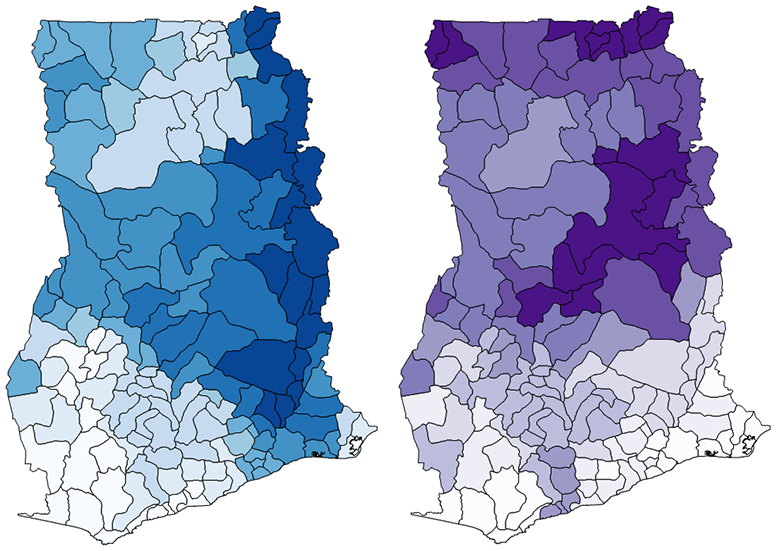The impact of growth on poverty in Ghana has slowed substantially over the years. Ghana’s largest fall in poverty, 2% a year, was experienced during 1991–1998. Between 2012 and 2016, the poverty rate declined by only 0.2% per year. The growth elasticity of poverty (percentage reduction in poverty for each percentage point in economic growth) has decreased, from −1.18 between 1992 and 1998 to −0.07 between 2012 and 2016. This may reflect the declining contribution of agriculture, in which the majority of poor households are engaged, the limited job opportunities for higher productivity in the services sector, and a largely capital-intensive industrial development.
In addition, Ghana has seen a persistent and increasing spatial inequality (Figure 1 ). Poverty rates have stagnated in the Volta, Northern, and Upper West regions and the absolute number of poor has increased. Poverty rates remain above 50% in the Northern, Upper East, and Upper West regions. Poverty rates also now vary widely across districts within regions. In the Northern regions, districts in the eastern part achieved significant poverty reduction while the western districts saw increase in poverty.
Figure 1: Concentration of Poverty across Districts
| 2000 | 2010 |
 |
|
| Sources: (Coulombe 2005) andGhana Statistical Service (2015). |
|
The spatial inequities reflect both ecological conditions and disparities in service delivery. Agriculture remains the dominant employer in the three Northern regions, but the climate is not suitable for cocoa and some other cash crops. Farmers in these regions are mainly engaged in rain-fed, traditional subsistence agriculture: they use few modern inputs, receive inadequate extension services, and have limited access to irrigation. There is also a substantial difference between poor and rich districts in access to electricity, markets, and roads. And unsustainable farming practices have led to lower soil quality, higher erosion, and lower agricultural output in these regions.
In addition, rainfall patterns have become even more volatile, and crop failure is more frequent. Mean yearly rainfall fell from 11.7 mm per year in 1901–1910 to 6.3 mm in 2011–2015 in the poorest third districts. The northern savannas, where subsistence agriculture is the main employment for poor households, have also been affected by frequent droughts and flooding accompanied by high temperatures and intense heat (Figure 2). Catastrophic floods in 2007, which affected 317,000 people, were followed immediately by drought—indicative of the high variability in climate and hydrological flows in northern Ghana.
Figure 2: Drought Severity in Ghana
| Number of floods (1985-2011) | Drought severity (1901–2008) |
 |
|
| Source: Hidden Dimensions of Poverty Dataset (HDD). |
|
Climate variability and environmental degradation are also seriously affecting the urban poor, mining, and coastal communities. Flood risk has become one of the most pressing problems in Accra, where the number of those who live in flood-prone informal settlements has grown. Fast growing artisanal and small-scale mining (ASM) operations, fueled by destructive practices and weak government controls, affect 75% of the country’s water courses and contribute to deforestation. Marine fish stocks are being adversely affected by domestic and industrial waste, pollution from fertilizers, and mining. Coastal communities face erosion and other risk from rising sea levels.
Sustaining growth over the long term will require Ghana to invest better and more in its natural resources. Ghana has lost half its forest cover since 2000, soil erosion is widespread, fish stocks are declining, and the artisanal mining sector has resulted in widespread pollution of waterways. These impacts are largely due to an inadequate regulatory framework and weak enforcement—increasing acreage to cocoa production reflects limited incentives for rising productivity versus clearing new forests; overfishing is affected by a lack of transparency in the licensing of commercial trawlers, while illegal mining has persisted and expanded. The limited attention to natural systems has left Ghana susceptible to climate change as has been seen from the increasing frequency and impact of droughts and flooding that disproportionately affect the poor.
This blog is the second in a three-part series to present the key findings of the Systemic Country Diagnostic for Ghana, Priorities for Ending Poverty and Boosting Shared Prosperity, along three areas: achievements, challenges and opportunities and pathways for the future.
Please see the first blog in the series, Ghana’s growth history: New growth momentum since the 1990s helped put Ghana at the front of poverty reduction in Africa




Join the Conversation